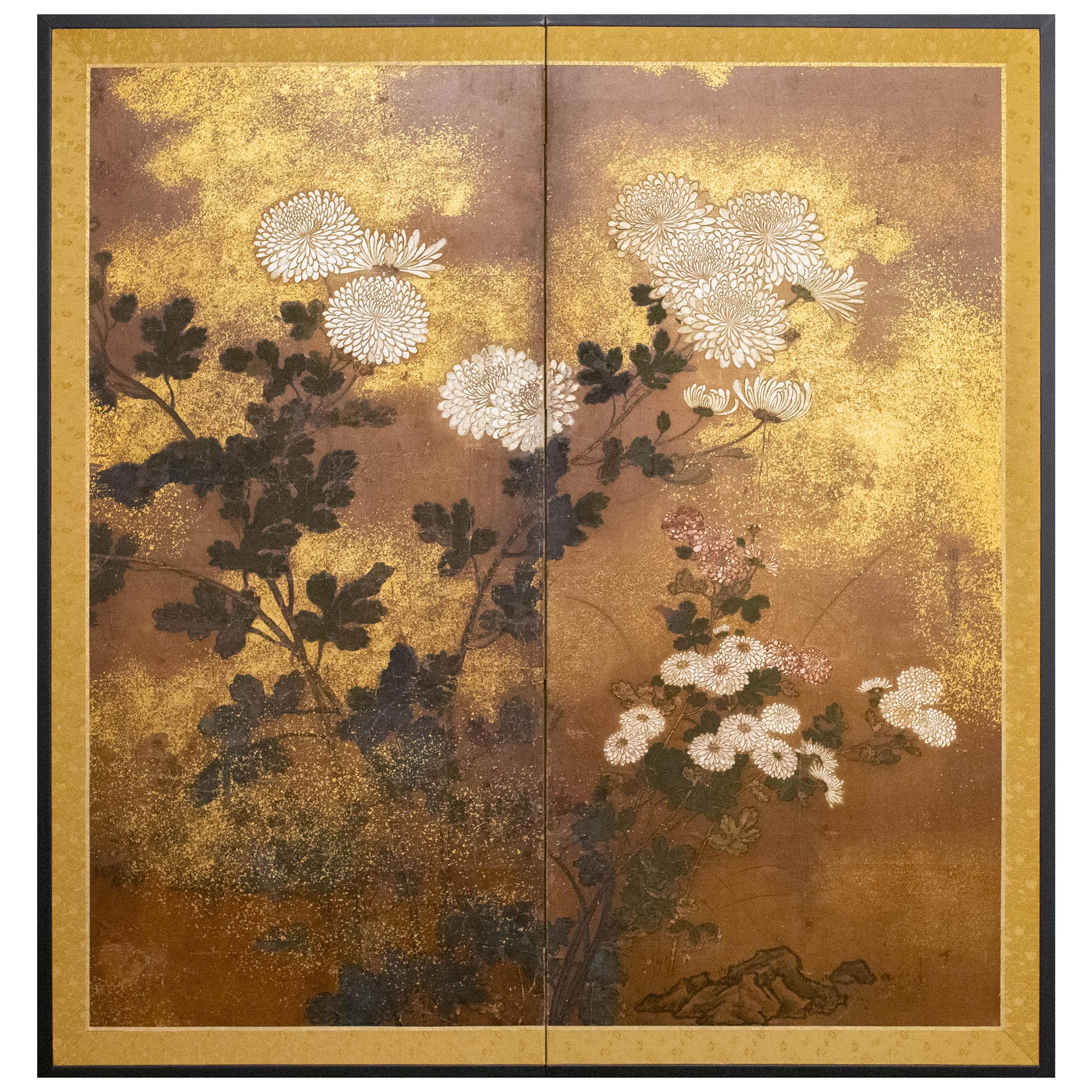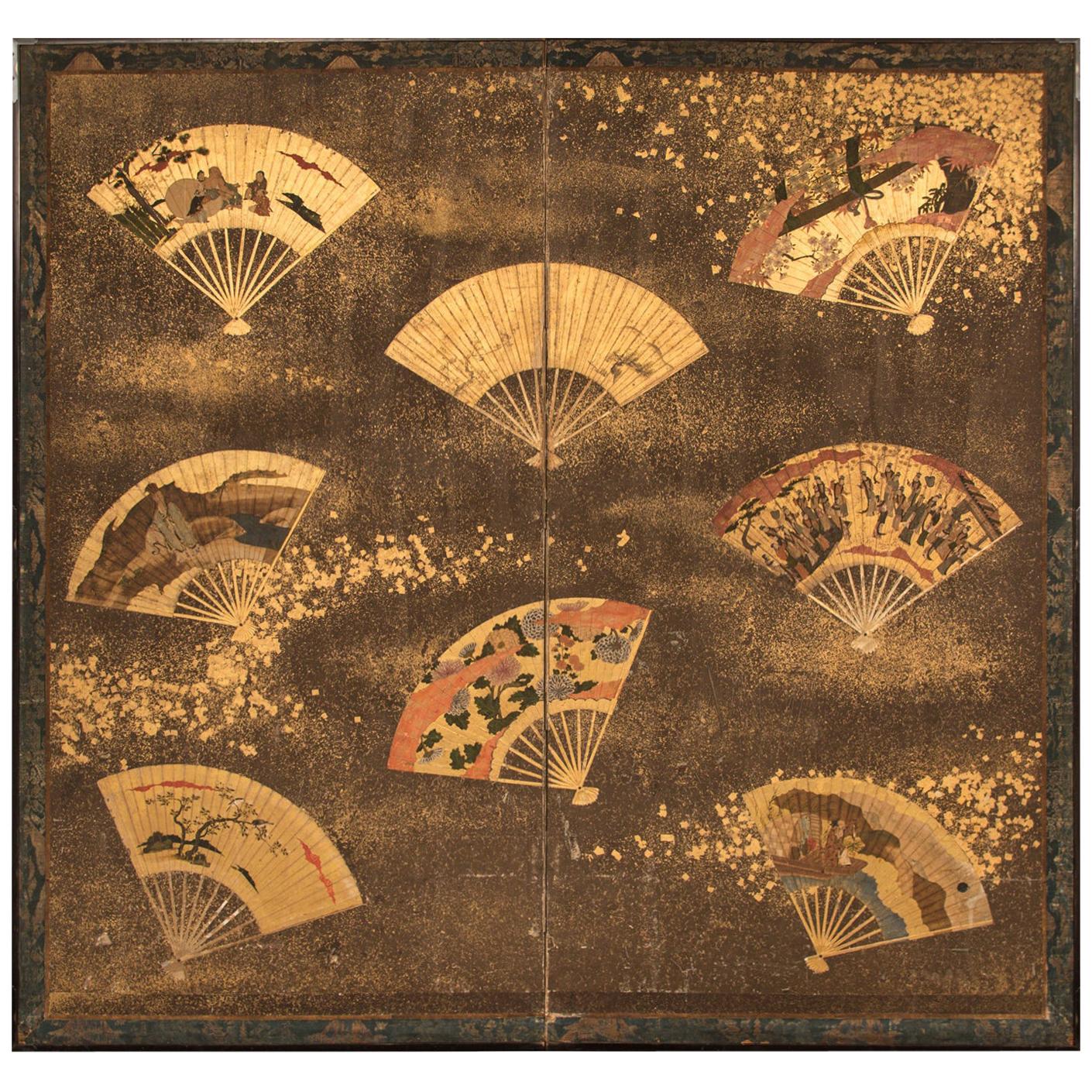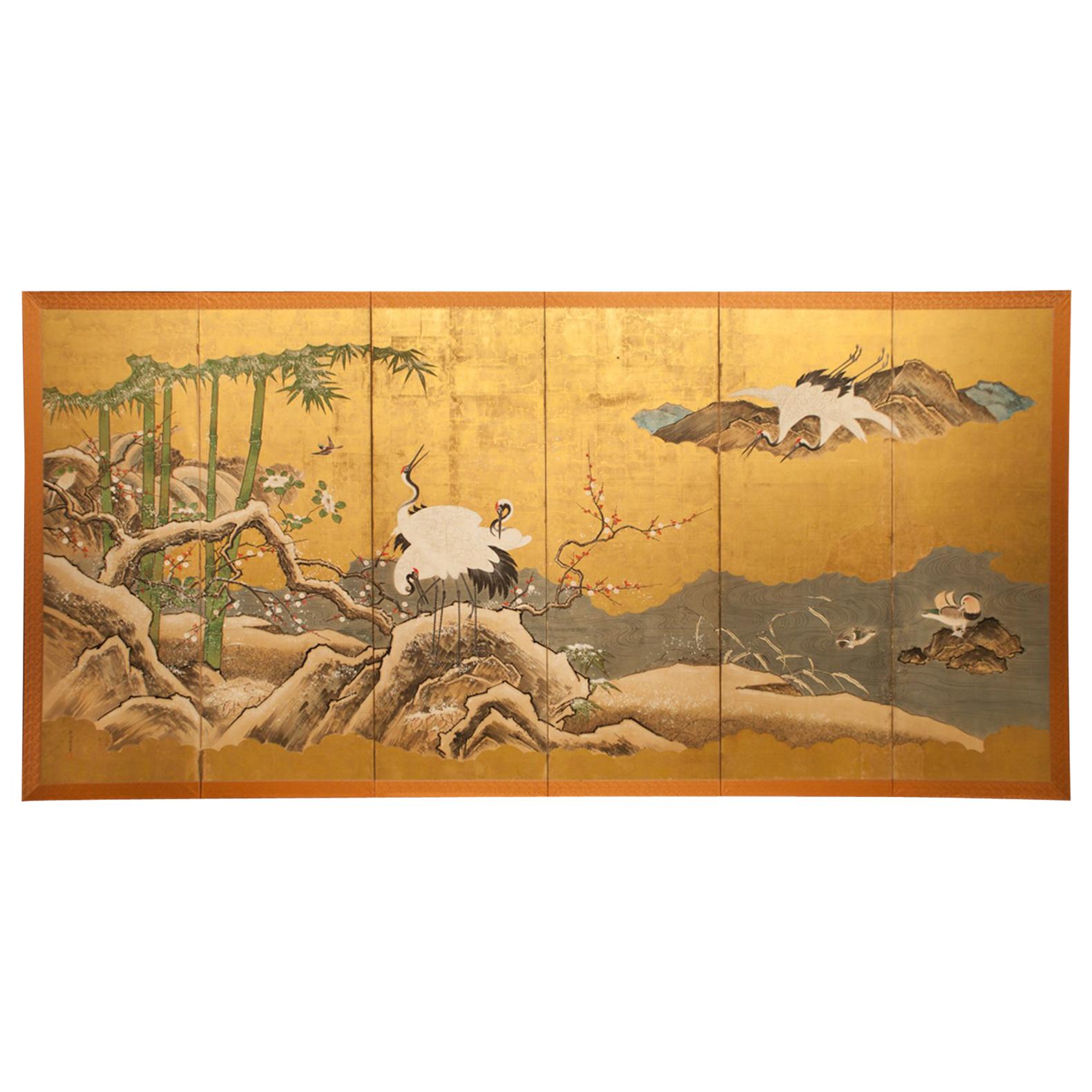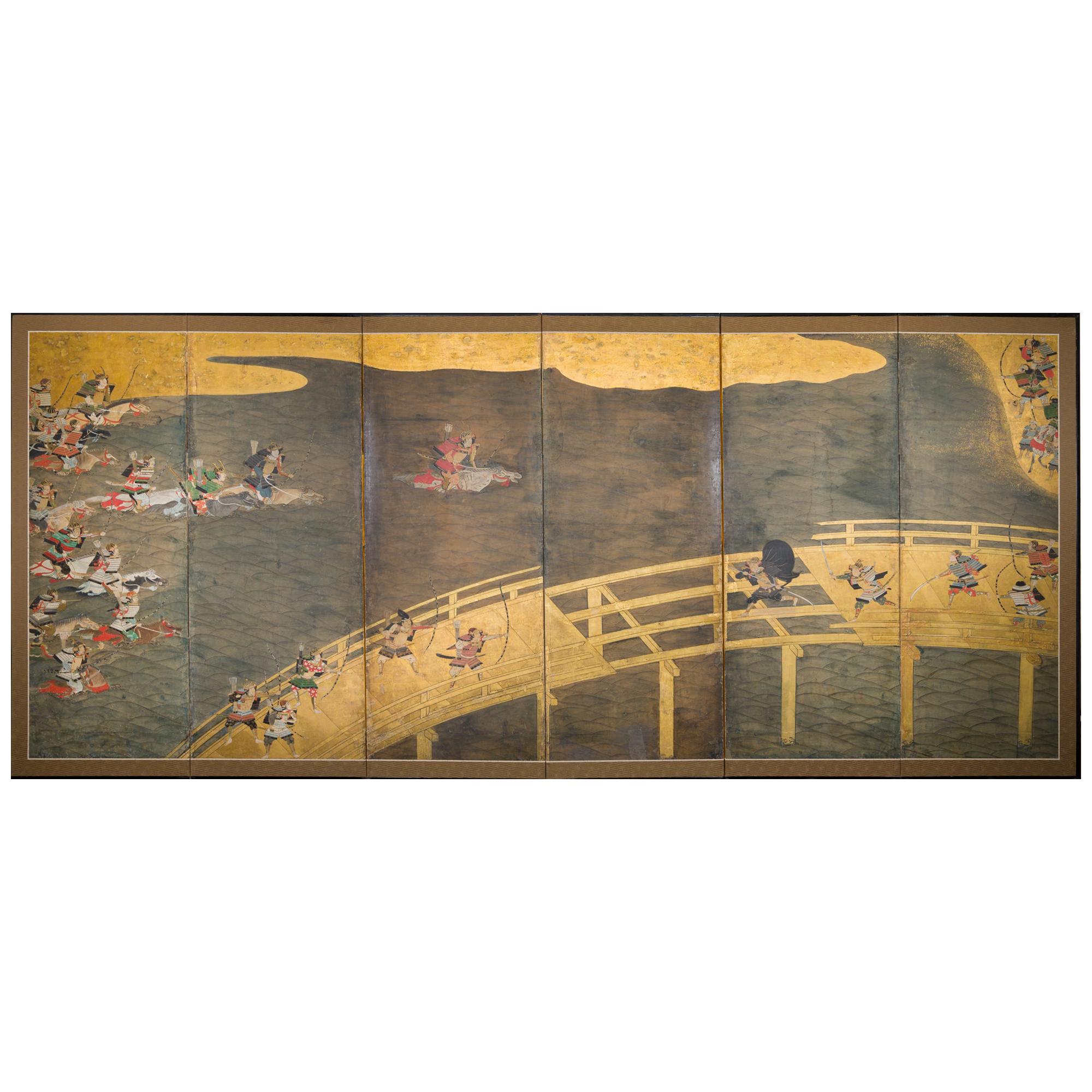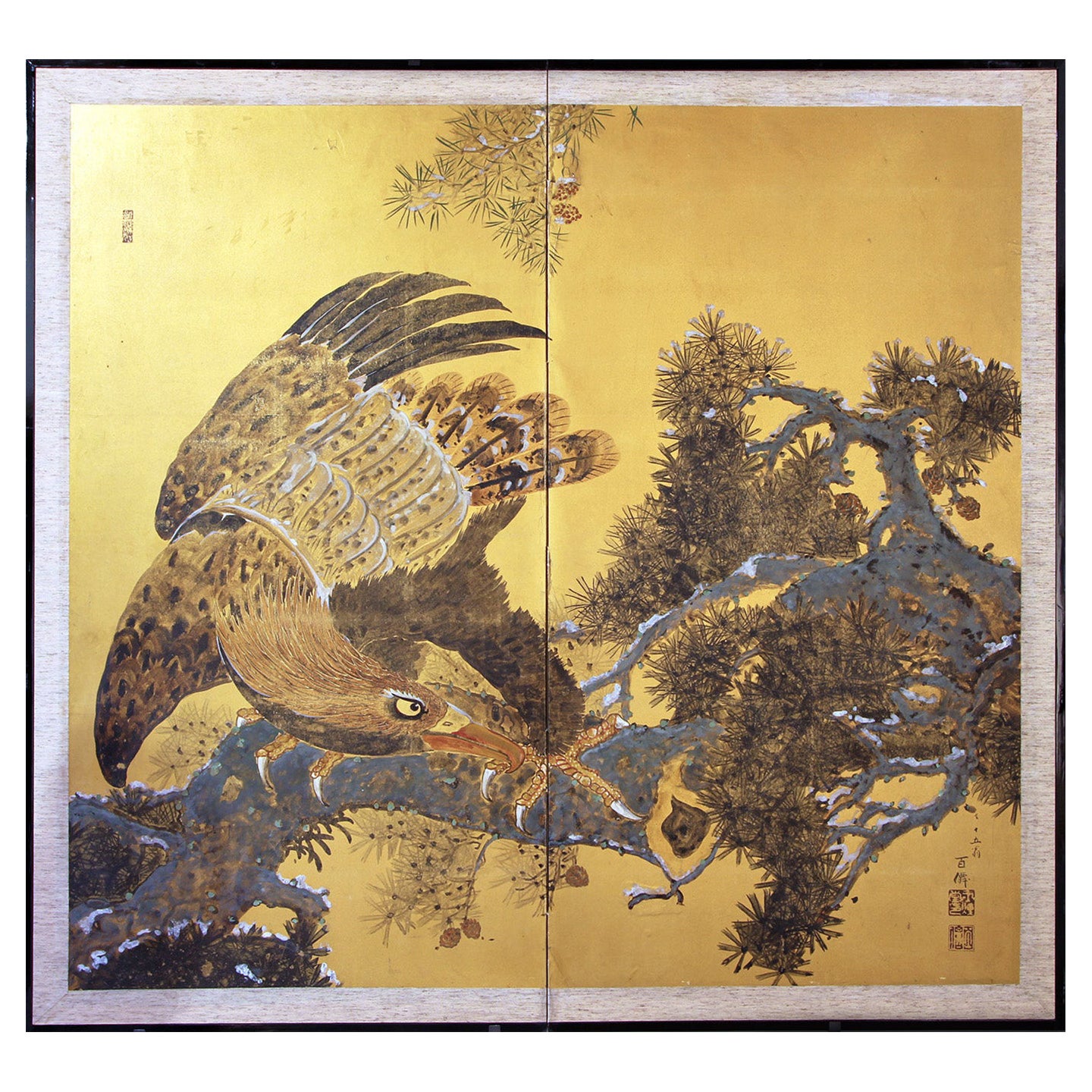Items Similar to Japanese Two-Panel Screen with Scenes at the Pleasure Quarters, 18th Century
Want more images or videos?
Request additional images or videos from the seller
1 of 7
Japanese Two-Panel Screen with Scenes at the Pleasure Quarters, 18th Century
About the Item
In the pleasure districts, the stringent codes were meant to be forgotten. In this painting, some clients are watching from outside the teahouse, while some are entering, one of them with the face hidden under a large basket hat. This ukiyo-e screen is representative of a type of genre painting that had its origins in Rakuchū rakugai zu, but which abandons a comprehensive view of the city for one that focuses on just one famous place, in this case, a pleasure district. The fictiveness of the setting is immediately evident from the impossible discontinuities of spatial recession, with a visual Paradox in which the figures in the foreground appears of the same size of those inside the tea houses: as the eye prioritizes human activities over natural settings, the proportions of the figures here reflect that visual hierarchy. The style and the subject matter recall two ukiyo-e artists who specialized in paintings from the pleasure district: Miyagawa Cho sun (1683-1753), whose style shows figures drawn with soft and curve lines, somehow feminine, and Hishikawa Moronobu (1618-1694), famous for his depictions of Yoshiwara.
- Dimensions:Height: 22.05 in (56 cm)Width: 0.79 in (2 cm)Depth: 63.19 in (160.5 cm)
- Materials and Techniques:
- Place of Origin:
- Period:
- Date of Manufacture:circa 1750
- Condition:
- Seller Location:Milano, IT
- Reference Number:
About the Seller
5.0
Recognized Seller
These prestigious sellers are industry leaders and represent the highest echelon for item quality and design.
Established in 2005
1stDibs seller since 2018
10 sales on 1stDibs
Typical response time: 3 hours
- ShippingRetrieving quote...Ships From: Milano, Italy
- Return PolicyA return for this item may be initiated within 7 days of delivery.
More From This SellerView All
- Pair of Japanese Screens with Flowers of the Four Seasons, 19th CenturyLocated in Milano, ITThis pair of screens belongs to a genre of lyrical paintings of flowers, grasses, and other plants that flourished around the middle of the 17th century and became a specialty of the Sôtatsu studio. The use of a rather complex composition of clusters of flowers and the puddling of ink was initiated by Tawaraya Sôtatsu, the founder of the Rimpa School, who was active from 1600 until 1642. The screens are abstract and decorative but there is, at the same time, a keen sense of naturalism not only in the attention to accurate detail but in the profusion of vegetation. The passage of the year is symbolized by the variety of plants that bloom in different seasons. The tarashikomi - here used on leaves, petals and trunks - is a Classic Rinpa technique in which pale black ink or a color is brushed onto an area of a painting and then either darker ink, or the same or a contrasting color, is dropped into the first before it has completely dried, creating an effect of pooled colors with softly blurred edges. Its delicacy, preciousness, and effeminacy are identified with the over-refinement of its patrons, while the vigor, monochromatic discipline, sharp observation, and virile forms of the Kano school are a testament to the vitality of the rising warrior class. The plants are almost all identifiable: in the summer-spring part, you can find wheat, buttercups, irises, begonias, hydrangeas, coral bells...Category
Antique 19th Century Japanese Paintings and Screens
MaterialsPaper
- Japanese Folding Screen with a Spring Landscape, Kano School, 19th CenturyLocated in Milano, ITThe scene is dominated by a plum tree in bloom under which a couple of paradise birds is courting. The screen is crossed by a luxuriant creek, a typical feature of the springtime.Category
Antique 19th Century Japanese Paintings and Screens
MaterialsPaper
- Pair of Japanese Two-Fold Screens with Flower Arrangements and Rare BirdsLocated in Milano, ITKaramono with flower arrangements and rare birds Edo period, 18th century Pair of two-panel folding screens Ink, colors, gofun and gold leaf on paper Each 170 by 165 cm ...Category
Antique 18th Century Japanese Paintings and Screens
MaterialsPaper
- Pair of Six-Panel Folding Screens with Peonies and Other FlowersLocated in Milano, ITA pair of six-panel folding screens with peonies and other flowers 19th century Each 72.5 by 241 cm Small and elegant screens with an ideal scene depicting peonies and other flower species...Category
Antique 19th Century Japanese Paintings and Screens
MaterialsPaper
- Hanging Scroll by Kamisaka Sekka, JapanLocated in Milano, ITThis painting represents a man waiting under a dark tree. The composition is extremely simple but suggestive. The artist, with few elements, can, in fact, create a vivid and dynamic scene, based on the tension between the strong ink stain that renders the tree and the elegant figure of the man, dressed in an aristocratic robe. Painter and designer, Kamisaka Sekka...Category
Early 20th Century Japanese Paintings and Screens
MaterialsPaper
- Painting by Maeda Josaku (Japan, 1926 – 2007), Paysage Humain N° 14, 1960Located in Milano, ITSigned: Josaku Meda. 60. Singed on the back: "Paysage humain" N°14 / 7.1960 / Josaku MAEDA / à Paris Exhibitions: Turin (Italy), Gissi Gallery, Collettiv...Category
20th Century Japanese Paintings and Screens
MaterialsCanvas
You May Also Like
- 18th Century Japanese Two-Panel Screen, Rimpa Painting of ChrysanthemumsLocated in Hudson, NYMineral pigments and gofun on paper with gold dust, and silk brocade border. Painting in good condition and mounting fresh. Signature reads, Shucho Sadayoshi. Japan, second half of t...Category
Antique Late 18th Century Japanese Paintings and Screens
MaterialsGold Leaf
- 18th Century Japanese Two-Panel Screen Collection of Fans on GoldLocated in Hudson, NY18th century Japanese Screen of a Collection of Fans. Paintings on fans depict famous Japanese painting subjects, this screen was most li...Category
Antique 18th Century Japanese Edo Paintings and Screens
MaterialsGold Leaf
- Japanese Six Panel Screen, Snow Scene at Water’s EdgeLocated in Hudson, NYJapanese Six Panel Screen: Snow Scene at Water's Edge with Flowers and Waterfowl. Edo period painting (mid 19th century) of plum, bamboo, white camellias, cranes and mandarin ducks ...Category
Antique Mid-19th Century Japanese Edo Paintings and Screens
MaterialsGold Leaf
- Late 17th-Early 18th Century Japanese Six-Panel Screen, Battle at Uji BridgeLocated in Hudson, NYJapanese six-panel screen: Battle at Uji Bridge, the first battle at Uji was in 1180 and it marked the start of the Heike Wars. The Genji troops crossed the...Category
Antique Late 17th Century Japanese Edo Paintings and Screens
MaterialsGold Leaf
- Japanese screen two-panelBy Japanese StudioLocated in Brescia, ITEagle on a pine branch with traces of white snow. A rare subject for this mid-century two-panel screen, painted in mineral pigments on gilded paper. The screen is a nice size and is ...Category
20th Century Japanese Showa Paintings and Screens
MaterialsPaper
- Japanese Two Panel Screen Harbor Scene in Abstract FormLocated in Hudson, NYAbstracted painting of ships moored in the background. Painted by Nishide Kofuku and exhibited at the 1963 Nitten National Exhibition. Kofuku was born in 1926 in Shiga Prefecture. He...Category
Mid-20th Century Japanese Showa Paintings and Screens
MaterialsMetal, Brass
Recently Viewed
View AllMore Ways To Browse
18th Century Painted Panels
Japan Soft
One Panel Screen
Large Screen Panel
Large Asian Screen
Tea House
Japanese Screens Large
Antique Place Setting
Antique Place Settings
Antique Quarters
Curved Screens
Paintings With Large Hats
18th Century City View
Brown Face Watch
Asia Hat
Tea Screen
Japanese Screen 18th
Japanese Tea House
